Contents
Japanese quince fruits are rarely used for fresh consumption. The structure of the pulp is hard, grainy, not juicy. Due to the presence of tannins in the composition of the fruit, the juice is astringent, and there is bitterness in the taste. Most often, the fruits are used for winter harvesting, for example, you can make jam, jam or wine from quince.
Features of making wine
For the preparation of an alcoholic drink, it is better to use Japanese quince. It contains a lot of sugars, and there are natural yeasts on the surface. Take varieties of any ripening period. After harvesting, the quince is not immediately processed, but left in a cool room. The fruits of early varieties can withstand two weeks, and late – 1,5-2 months. During this time, the structure of the fruit will become softer, and bitterness will disappear in the taste.
It is advisable to first prepare the must, then make wine based on it. This technology allows you to increase the shelf life of the drink. Raw materials are placed in any fermentation tank, the main thing is that the size of the neck allows you to set the shutter. To do this, use a rubber medical glove with a pierced finger or lead a rubber tube into the water.
There are several reasons why wine may fail. If you exclude them, then there will be no problems with preparing a homemade quince drink:
- Poorly processed fermentation or starter container. Before processing quince, the container is washed with soda, rinsed and poured over with boiling water.
- The ratio of the components of the recipe is not observed.
- In the process of transfusing the starter, bacteria got into the fermentation tank. It is recommended that all intermediate processes be carried out with medical gloves.
- Quince is poorly processed, partitions or seeds got into the workpiece.
And the most common reason is that low-quality fruits were used for the must.
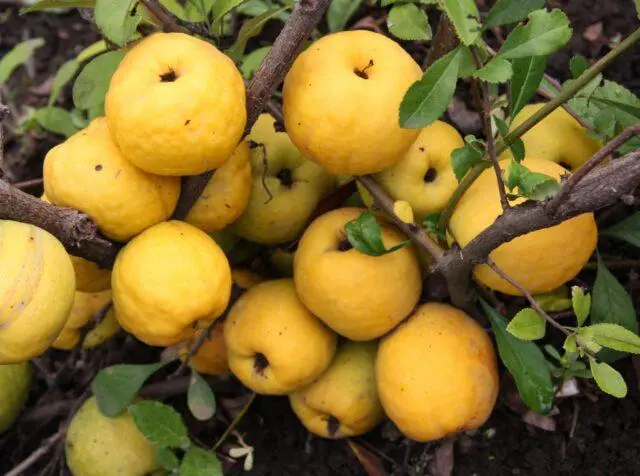
The fruits of Japanese quince are rounded, with a bumpy surface, bright yellow, contain a large amount of ascorbic acid.
Selection and preparation of ingredients
Raw materials for wine are used only of good quality, the taste, color, and aroma of a low-alcohol drink will depend on this condition. The fruits are taken only when ripe. Pay special attention to appearance. The quince fruit should have a smooth, bright yellow skin. If there are dark spots or signs of mold, rot on the surface, the affected areas can be cut off.
Quince preparation:
- If the recipe does not provide for yeast, then the fruits are not washed. If the surface is dirty, wipe it with a dry cloth.
- Quince is cut into two parts and the core with seeds is completely removed.
- Raw materials are passed through a meat grinder, press or cut into pieces.
The pulp of fruits contains a small amount of juice, so water is added to the must. For these purposes, you can use settled or spring.
Recipes for making quince wine at home
Japanese quince wine is made with the addition of apples, grapes, lemon or in the classic way – without additional components. There are options when raw materials are preliminarily subjected to heat treatment. The result is a low-alcohol drink. If desired, it can be fixed with vodka or alcohol. A few of the most common options will help you make your own wine.
Классический
Components:
- quince – 10 kg;
- sugar – 500 g at stage 1, then 250 g for each liter of liquid;
- citric acid – 7 g / l .;
- water – 500 ml per 1,5 liters of liquid.
Technology:
- Quince is not washed. The core is removed, the fruits are cut into pieces and rubbed on a grater with a fine grate or a meat grinder is used.
- The workpiece is placed in an enameled or plastic container.
- Dissolve 500 g of sugar in cold water, add to quince.
- Cover with a cloth napkin on top so that foreign rubbish or insects do not get into the workpiece.
- The resulting wort is left for 3 days to start fermentation. Stir occasionally.
- If pulp particles float to the surface, they are removed with a clean slotted spoon. Within 8-12 hours of the first day, the leaven will ferment.
- The wort is filtered, the pulp is carefully squeezed out, the waste is discarded.
- Measure the volume of the resulting liquid. Add citric acid according to the recipe, water and sugar at the rate of 150 g per 1 liter. Stir until the crystals dissolve.
- The raw materials are poured into a fermentation tank and a shutter is installed.
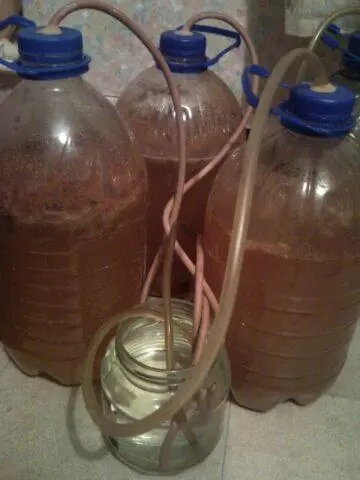
The simplest version of a water seal can be made from tubes from a dropper
For full fermentation, provide a room temperature of 22–27 0C.
Algorithm for further actions:
- After 5 days, the shutter is removed, a little liquid is drained and 50 g of sugar (per 1 liter) are dissolved in it. Pour back, return the water seal.
- After 5 days, the procedure is repeated according to the same scheme: sugar – 50 g / 1 l.
- Leave the wine to ferment.
The process can take from 25 days to 2,5 months, readiness is determined by the shutter.
The won wine is separated from the sediment and bottled or glass jars, the temperature is lowered to +10–15 0C. The infusion process takes 5-6 months. At this time, the appearance of sediment is monitored. It is separated periodically.
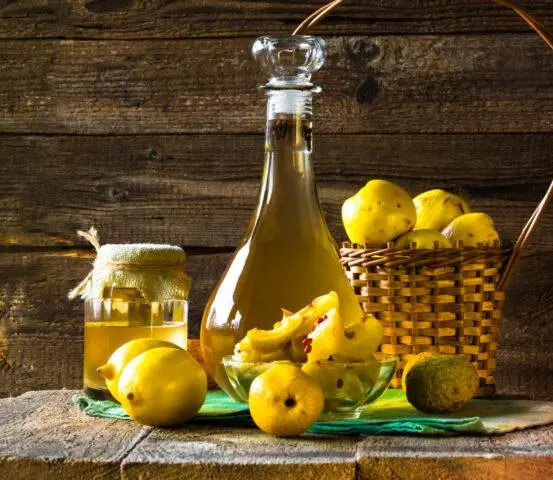
When the wine becomes transparent and there is no cloudy mass at the bottom, it is considered ready.
With lemon
The recipe with lemon has a balanced sweet and sour taste. Required components:
- lemon – 6 pcs .;
- quince – 6 kg;
- water – 9 l;
- sugar – 5 kg;
- yeast (wine) – 30 g.
Wine making process:
- The fruits are ground to a puree state. Put in a container for cooking.
- Add water, stir and boil the workpiece for 15 minutes.
- Remove from stove and leave for 4 days
- Carefully separate the liquid from the sediment.
- The zest is crushed.
- Lemon, yeast and sugar are added to the liquid.
- Placed in a container with a water seal.
- The fermentation process will be short-lived, when it ends, the wine is poured into a clean container. Suitable 10 l glass jar. Leave to insist.
During the aging process, the precipitate is periodically separated. Then it is bottled.

An alcoholic drink has a strength of 15–20%
A simple recipe
This is the easiest option that even novice winemakers can use. Minimum ingredients required:
- quince – 10 kg;
- sugar – 150 g per 1 l;
- water – ½ of the volume of the juice obtained.
Phased technology:
- Processed quince is passed through a juicer.
- Combine juice and pulp, measure the volume.
- If there is a lot of raw materials, pour it into an enameled bucket.
- Raw water is added at the rate of 5 liters per 10 liters of wort.
- Sugar is poured in a proportion of 100 g / 1 l, after dissolving it in water. They taste: the wort should not be cloying or sour. It is best if it turns out to be a little sweeter than regular compote.
- The container is covered with a clean cloth and put on preliminary fermentation for 4 days.
- When the process starts, a foam cap will appear on the surface. It must be stirred several times a day.
- The mass is filtered, tasted for sweetness. If the workpiece is sour, add water and sugar.
- Poured into containers with a water seal.
After 10 days, the precipitate is drained and sugar (50 g/1 L) is added.
When the process is completed, bottled, left to infuse.
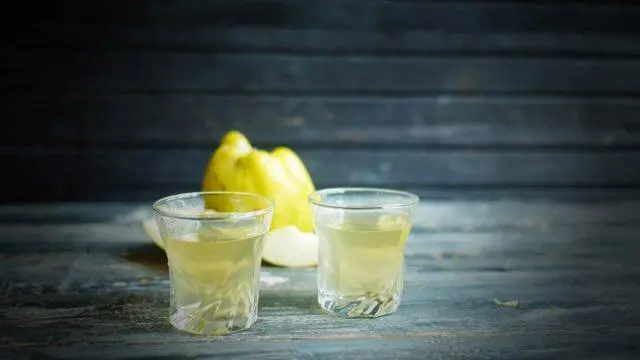
To increase the strength, vodka or well-purified moonshine is added to the finished product.
With grape
Grape and quince drink will appeal to everyone. Required components:
- grapes – 4 kg;
- quince – 6 kg;
- sugar – 1,5 kg;
- water – 4 l.
Wine making process:
- The grapes are not washed. It is pressed to a homogeneous mass along with the fruit brush.
- Quince is crushed to a puree state in any convenient way.
- Combine fruits, add water. Pour 550 g of sugar previously dissolved in water.
- The container is covered. Fermentation will take 3 days.
- The mass is well squeezed, add 2 liters of water, taste it, add sugar if necessary.
Poured into containers with a water seal. After two weeks, filter from the sediment, add sugar. Leave the wine to ferment. Then the precipitate is drained and insisted.
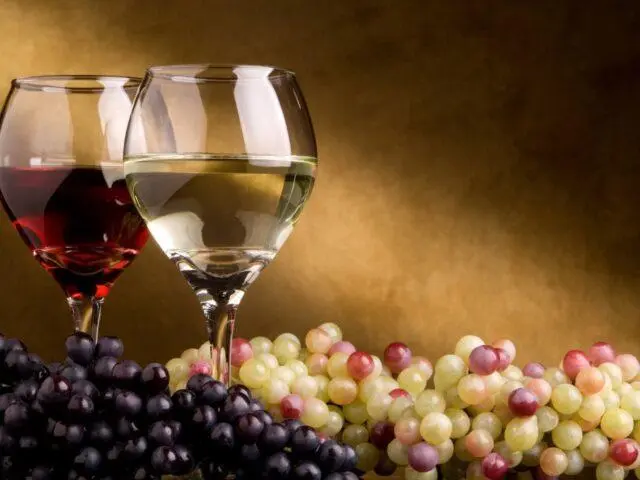
With white grapes, quince wine turns light yellow, with the addition of blue – dark pink
A sparkling wine
A low-alcohol drink prepared in this way is similar to champagne.
Components:
- quince – 1 kg;
- sugar – 600 g;
- vodka – 500 ml;
- wine yeast – 2 tbsp. l.;
- water – 5 l .;
- raisins – 2 pcs. for 0,5 l.
Technology:
- Syrup is brewed. When it cools down, pour it into a fermentation container.
- Quince is cut into small cubes, sent to the syrup.
- Add yeast and vodka.
- Install a water seal. Keep warm for two weeks. The temperature is lowered to 15–18 0C and the workpiece is not touched until fermentation is completed.
- The sediment is carefully separated, bottled.
- Add 2 pcs to each. unwashed raisins.
- Clog containers with resin or sealing wax.
Lay horizontally in the basement.

Quince sparkling wine will be ready in 6 months
With barbaris
Additional ingredients are often added to an alcoholic drink, giving interesting notes. Winemakers recommend making wine from quince with barberry berries. To prepare it, you need a minimum of ingredients. Ingredients of the drink:
- barberry – 3 kg;
- quince – 3 kg
- sugar – 4 kg;
- raisins – 100 g;
- water – 12 l.
Technology:
- Fruits and berries are crushed to a homogeneous mass.
- Put in a container, add raisins and 1 kg of sugar.
- Leave for pre-fermentation for 3 days. The mass is stirred.
- The raw materials are squeezed as much as possible, placed in a fermentation dish.
- Add water, 2 kg of sugar. Close with a water seal.
- After 10 days, they are decanted, the sediment is poured out. Add 0,5 kg of sugar.
- After two weeks, the procedure is repeated.
When the wine is won, it is bottled for infusion and lowered into the cellar for 6 months. The sediment is periodically removed.
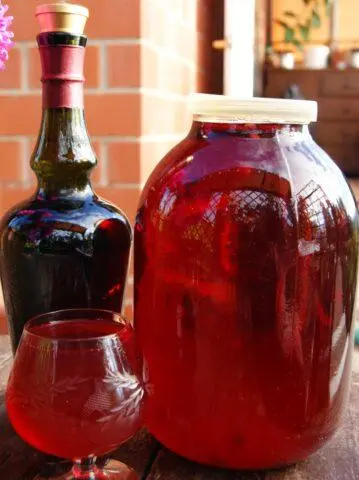
Barberry gives the drink a dark pink color and complements the aroma.
Terms and conditions of storage
Quince wine is considered ready if there is no sediment at the bottom. Until this time, it has been separated several times. The winning drink is bottled and hermetically sealed. Wine must be stored in a dark place with a temperature not higher than +7 0C. Experts recommend not to put bottles, but to place them horizontally. The shelf life of a low-alcohol drink is 3–3,5 years.
Conclusion
Quince wine has a high content of iron and potassium. It contains a rare vitamin K2, necessary for the absorption of calcium. Wine is made only from quince or with the addition of citrus fruits, grapes. The drink turns out to be low-alcohol. It has an amber color and a pleasant tart aftertaste.









